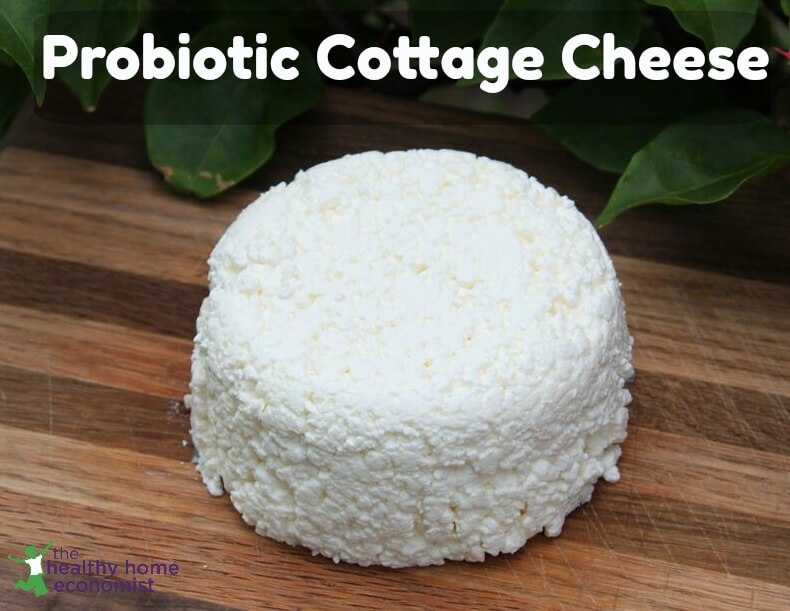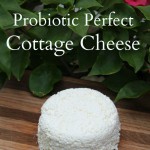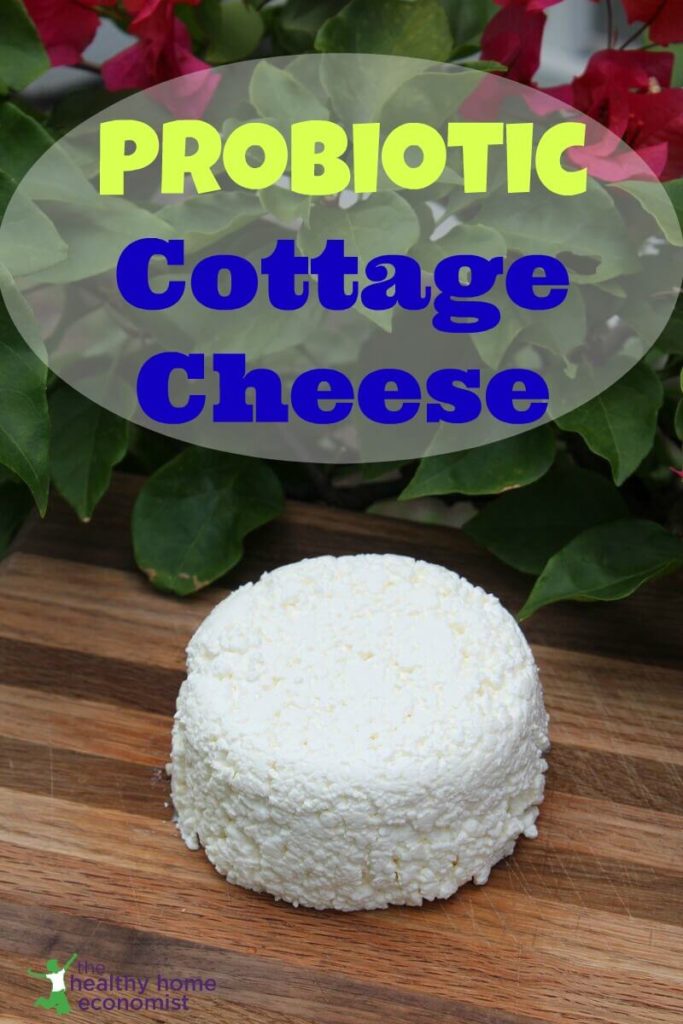Easy recipe for full fat cottage cheese with probiotics and enzymes intact which is virtually impossible to find at supermarkets or healthfood stores.

In the Western world, cottage cheese is nearly synonymous with dieting and all things related to the pursuit of skinny.
Cottage cheese is typically served with sliced fruit on top as an ultra low-calorie meal. It’s been the poster child for losing weight since the lowfat dogma of the 1960s took hold and escorted Westerners down a path to even greater weight and health challenges.
Unfortunately, the madness continues in conventional circles to this day. The American Heart Association recently blasted coconut oil as heart unhealthy. Seriously?
Why then did ancestral cultures that ate LOTS of it suffer virtually no heart disease? No wonder an increasing number of people don’t pay any attention and choose to do their own research.
While cottage cheese is certainly a nutritious, traditional food (Little Miss Muffet was probably eating something similar while sitting on her tuffet), it has, in the modern sense, seriously lost its way.
Supermarket and even organic health food store cottage cheese is highly processed and lowfat. Such concoctions are more likely to trigger binge eating than satisfy and proactively assist with sustainable weight loss goals.
This is because the skim milk from which the cottage cheese is made, organic or not, has had all the nutrient-dense cream removed. Worse, it has been pasteurized at high temperatures destroying much of the nutrition (Vitamins C and E, B12, B1, B2, folate). Digestive enzymes and beneficial microbes known as probiotics are obliterated as well.
And, as anyone who truly understands nutrition knows, skim milk and anything made with it encourages weight gain much more readily than helps you lose weight! Just ask any pastured pig farmer – skim milk is a key tool to get the pigs really fat!
Sourcing Truly Healthy Cottage Cheese
Finding probiotic and enzyme-rich, full fat cottage cheese is very difficult if not impossible depending on where you live. If you’re lucky enough to source locally, chances are it will be from a small grassfed dairy.
As a result, if you’re a cottage cheese lover like I am, it’s best to learn how to make it yourself. Fortunately, the process of making truly traditional cheese of the modern cottage variety is simple.
And, when you handcraft and consume curds and whey in this manner, it really will help you with your weight loss goals because, in a word, it will truly satisfy!
Probiotic, Enzyme Rich and Full Fat
The best recipe for full fat, raw cottage cheese (newsflash: the way it’s supposed to be) that I’ve seen is actually illustrated in The Nourishing Traditions Cookbook for Children.
That’s right, healthy cottage cheese is so simple to make a child can actually do it!
If you want to teach your children the basics of traditional cooking, this lovely little cookbook is a must-have. It’s spiral bound for easy page flipping by little hands and contains ingredient illustrations instead of hard to follow ingredient lists.
My daughter and I have been poring through it this summer to expand her culinary knowledge. I highly recommend it for anyone with children 10 and under.
Homemade Cottage Cheese
Many thanks to author Sally Fallon Morell for generously allowing the sharing of this recipe and ingredient illustration from The Nourishing Traditions Cookbook for Children.
Equipment Needed
The image below shows the equipment and ingredients you will need to get started making the homemade cottage cheese recipe.


Cottage Cheese Recipe
Easy recipe for full fat cottage cheese with probiotics and enzymes intact which is virtually impossible to find at supermarkets or healthfood stores.
Ingredients
Instructions
-
Pour the milk into a large mixing bowl (I use these glass bowls). Cover the bowl with a plate and leave it in the refrigerator until all the cream rises to the top. This might take up to 24 hours.
-
Skim off the cream with a spoon or easier still, a stainless steel turkey baster, and save it in a pint sized glass mason jar or similar container in the refrigerator (hint: you will use it later!).
-
Mix the kefir or yogurt into the milk with a spoon. Cover the bowl with a plate once more and leave on the counter at room temperature until the milk thickens like yogurt. This is what is called the curd and it will take 1-2 days depending on your home’s temperature and the freshness of the raw milk.
-
Using a knife, cut the curd in the bowl into tiny squares by slicing through it from top to bottom and left to right. Try to keep the cuts no larger than 1/4 – 1/2 inch (.64 cm – 1.3 cm) apart.
-
Fill a medium sized pot with filtered water about 1 inch deep. Put the pot on the stovetop with the burner set to low heat. Place the bowl of curds with the plate removed on top.
-
Test the temperature of the curds every 5 minutes with a digital food thermometer. After each 5 minute check, stir the curds for a few seconds. Continue with this process for about 30 minutes (6 – 5 minute checks) until the curds reach 110 F/43 C. All enzymes and probiotics will be preserved if you only heat to this low temperature. How to know? If you stick your finger in and don't get burned, no destruction of beneficial microbes or enzymes has occurred. This would happen if you heat the milk higher than 117 F/47 C, which is why it is so important to keep checking the cottage cheese every 5 minutes to ensure that the temperature doesn't get too high.
-
Remove the bowl from the heat when the desired temperature has been reached and separate the curds from the whey with a strainer set inside a mixing bowl. The curds will stay in the strainer and the liquid whey will run into the bowl underneath.
-
Rinse the curds still inside the strainer with cold, filtered water. Be sure to very gently stir the curds with a spoon until all the water drains out.
-
Put the curds in a container and mix with the sea salt and reserved cream you have in the refrigerator. You now have raw, full fat cottage cheese with all the beneficial probiotics, vitamins and enzymes from the raw milk still intact! Cottage cheese is delicious freshly made, but be sure to refrigerate any leftovers. In my experience, this truly traditional cottage cheese lasts for several weeks in the refrigerator.
Recipe Notes
Full fat yogurt may be substituted for the kefir. These yogurt brands are best.
More Information on Healthy Cheese
If learning to make cheese is exciting to you, check out my other cheesemaking posts here:









This turned out beautifully. In my transition to raw milk, cottage cheese is what I have missed the most. Thank you so much for sharing this recipe.
I was so excited to make this cottage cheese. Started with the raw milk and used kefir that I make at home. The mixture has been sitting for 3 days. It has not curdled past the kind of gelatinous phase that my milk kefir gets to. It still tastes good, but I dont think it’s ready for the colander. Did I do something wrong?
Kris
Double check your measurements .. did you use 1 full cup of kefir to only 1/2 gallon raw milk?
I am having a similar problem… after 2 days the mix looks more like yogurt then curd. Its been in the 70’s here. I am pretty sure I used the correct measurements. Does it go through a yogurt like phase before turning to curds? if measurements were incorrect could I add more yogurt at this time? Also… could I transfer the curds to a stainless steel double boiler?
My glass bowl cracked. I dumped out the curled milk and threw away the bowl. What did I do wrong? Why not just hear the curdled milk in the pot itself continually stirring?
I don’t know … maybe the bowl was old or not of the type of glass that can be heated slightly? I’ve had bowls crack before when nothing was actually done wrong.
My first batch is sitting on my counter culturing. I’m not sure I can wait another 2 days to try the finished product. I live in Massachusetts and raw milk is fairly easy to come by so I consider myself lucky. Quick question: I was going to buy kefir for the starter, but most of them said “Lactose Free.” Is this just a by-product of the kefir making process? I make water kefir at home and know the sugar I use is eaten by the grains, and I wondering if the milk kefir does the same for the lactose?
Yummy Yummy I love everything with cottage cheese! Love this recipe.
I am not able to tolerate cow’s milk. Will this recipe work if I can find raw, grass fed goat’s milk instead? Also, since so many of the recipes in Nourishing Traditions call for whey (especially the fermented ones), which I can’t have, is there anything I can use as a substitute, or is it ok to omit it in most of the recipes (sometimes itis listed as optional)?
Yes, it should work fine with goat milk 🙂 You can make whey from goat milk too and use that instead of cow milk whey.
“The poster child for losing weight since the misguided lowfat dogma of the 1950’s took hold and escorted Westerners down a path to even greater weight and health challenges”
But we didn’t lower our fat intake in the way you’re saying. We increased it in the form of polyunsaturated vegetable oils.
All saturated fats were cut out as much as possible! Yes, vegetable oils were used instead for processed foods, but for cooking, no oil whatsoever was considered the “best”. Note all the fat free products, removing all the drippings from cooked meats, and drizzling lemon juice on salads. Crazy!
My grandmother, who would be about 105 years old now, just sat the bowl of milk on the back of her counter and waited for it to curdle. Of course, she had her own cow. She also cooked on a wood cook stove, no matter what time of year. In Missouri, no less! 🙁 I did this when we had our own cow. I don’t normally care for cottage cheese, but I loved it! No cooking at all. I may have strained out the liquid…..can’t remember for sure if there was enough to bother with. It’s been a few years. No separating. No additives. Just stir. The curds were very small. The yogurt or kefir probably does increase the probiotic/enzyme count. Thank-you for posting this.
Thank you for sharing this memory. It’s so important for us to remember what our grandmothers and great-grandmothers did in the kitchen as so much has been lost since WWII and the rise of processed foods.
I have a question – I have seen many methods where they use a cheese cloth at the very end to separate the curds and the whey. It doesn’t seem that you have done that, just used a strainer. The videos and how-to’s up until yours use a cheese cloth, one person even warning against anything that could let the curds pass through at all. Could you give some insight into that last part, and maybe recommend a strainer we should use? A lot of people SQUEEZE out the whey as much as possible and rinse multiple times with water as well. Any help is greatly appreciated!!
You could use a cheesecloth for this recipe too if you like. I prefer a strainer because it is easier to run the filtered water over the curds to rinse the rest of the whey out. If you cut the curds to the size specified in the recipe, they won’t pass out of the strainer.
Wonderful. Thank you so much! Just picked up my ingredients today and will be starting the process tomorrow! Just another question: is the reason you add the yogurt for the healthy bacteria? I got Greek yogurt, I hope that’s okay!
I have been following the recipe you posted a while back for raw yogurt except that I don’t warm the milk at all, just stir in the yogurt and let it sit 24 hours. It’s thinner than regular yogurt, but so delicious and I’ve been using each batch to culture the next for the last month or two now. I tried straining it once for 7 or 8 hours and the curds part was almost exactly like cottage cheese from the store! I will probably use this method if I want to make cottage cheese again. Thanks for the yogurt recipe!
Yes, raw yogurt has a thinner consistency (drinkable style) than heated yogurt which is thicker. Glad you enjoyed it!